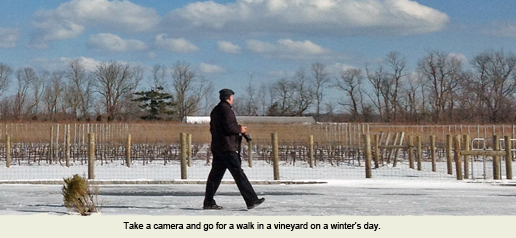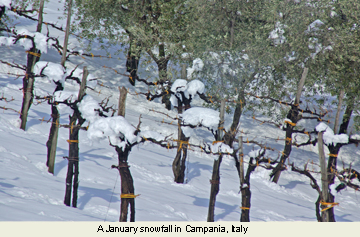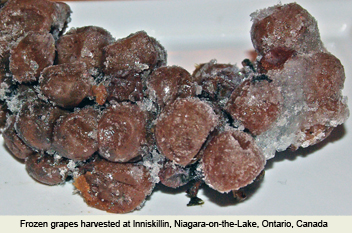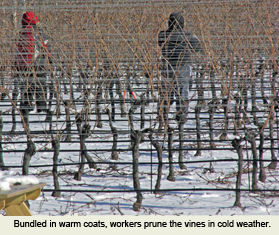A Walk in a Vineyard on a Winter’s Day
by
Terry Sullivan
Caught by an iPad camera, Terry explores a vineyard in the North Fork on Long Island on a cold, wintry day. Winter is a favorite time to walk through vineyards. It is a time for rest and sleeping. Although many vineyard managers and winemakers suggest that we visit while the grapes are on the vines, we feel that vineyards are a delight every season. Winter has its specialities.

 While touring wineries in the Campania wine region of Italy, after the International Wine Tourism Conference in Perugia, we had a rare chance to see snow gently kiss the vines. The vines look like pillars rising from a sea of white. Snow hugs a cordon, a scene unique during winter in some areas of the region. Snow can provide a blanket for the vines attesting to the rest this season provides.
While touring wineries in the Campania wine region of Italy, after the International Wine Tourism Conference in Perugia, we had a rare chance to see snow gently kiss the vines. The vines look like pillars rising from a sea of white. Snow hugs a cordon, a scene unique during winter in some areas of the region. Snow can provide a blanket for the vines attesting to the rest this season provides.
Photography has its advantages during the winter. This is the season where one can observe a vine’s architecture. If the vines were pruned, an eye or camera lens can catch the predictive architecture of the next growing season. Taking photos, prior to pruning, provide a glimpse of the epilogue of the year passed by. Then there are the snow photos. Not all vineyards throughout the world see snow during the winter. For those that do experience snowfall, the vines do make a nice contrast to the sparkling white blanket covering the floor of the vineyard. Wet snow clings to canes and trunks and can pile up several inches providing photographic scenes.

 In some very cold regions, winter is the time that temperatures dip to -8º Celsius and below. When this occurs, grapes are harvested to make Icewine. The frozen grapes are rushed to a press and pressed while the temperatures are quite cold. The result is about a drop or two of juice per grape. But this precious drop is very high in sugar and helps make a dessert wine that some look forward to for a year.
In some very cold regions, winter is the time that temperatures dip to -8º Celsius and below. When this occurs, grapes are harvested to make Icewine. The frozen grapes are rushed to a press and pressed while the temperatures are quite cold. The result is about a drop or two of juice per grape. But this precious drop is very high in sugar and helps make a dessert wine that some look forward to for a year.
 Although winter vines may be at rest, human caretakers brave the elements to prune by hand. Depending on the number of vines and the work force, pruning can take weeks even months. January and February are the months that most pruning is done in the northern hemisphere. Snow may cover the ground, but workers brave the elements to take advantage of this vineyard work. When the weather is brutally cold, vineyard workers often still prune the vines, they do take longer breaks to regain the feeling in their hands and fingers.
Although winter vines may be at rest, human caretakers brave the elements to prune by hand. Depending on the number of vines and the work force, pruning can take weeks even months. January and February are the months that most pruning is done in the northern hemisphere. Snow may cover the ground, but workers brave the elements to take advantage of this vineyard work. When the weather is brutally cold, vineyard workers often still prune the vines, they do take longer breaks to regain the feeling in their hands and fingers.
Winter has its challenges. Some wine regions have to take extra measures in order for Vitis vinifera vines to survive. One region visited in Canada maintains their vineyards quite differently during the winter. Temperatures in Prince Edward County can reach below -30 degrees Celsius. Vinifera grapes are not able to survive these cold temperatures. Rather than hoping to produce Icewines, workers shorten the vines and tie them on a low cordon wire. A heavy layer of soil, around eighteen inches deep, is piled on top of the buried vine. In early spring the vines are uncovered. A tremendous amount of extra work goes into this process but the wineries who take on this extra work and expense are proud of the vinifera wines they produce.
Vineyards are dormant during the winter, renewing their energy for the birth of a new season. Viewing winter vineyards reveals scenes that predict the future. Take time for a walk in the vineyard on a winter’s day.
Article written January 2013
